Dutch painter Rembrandt van Rijn's 407th birthday is being celebrated by Google through a doodle featuring his self portrait.
The self portrait or 'Self-Portrait with Beret and Turned-Up Collar' was made by Rembrandt in 1659. It is an oil on canvas painting and a celebrated work of the painter. The painting has been preserved in the National Gallery of Art in Washington DC (US) since 1937, where it's part of the Andrew W. Mellon Collection.
Rembrandt van Rijn is known as one of the greatest painters in Europe and Dutch Republic (Netherlands). The period when he contributed to art, is known as the Dutch Golden age which was known for its cultural achievements.
Art connoisseurs of the 20th century claimed that Rembrandt had made more than 600 paintings, about 400 etchings and 2,000 drawings, though modern day findings under Rembrandt Research Project mentions that he had done about 300 paintings. Among these, 40 paintings are said to be self-portraits. His work runs across the themes of portraits, landscape and narrative painting. His paintings featured rich detail, and depicted religious themes as well. Some of his greatest works include The Abduction of Europa, Judas Repentant, Returning the Pieces of Silver, The Artist in His Studio, Cottages before a Stormy Sky, The Three Trees, and The Night Watch, among several others.
Rembrandt van Rijn was born on 15 July 1606 in Leiden, in the Dutch Republ.
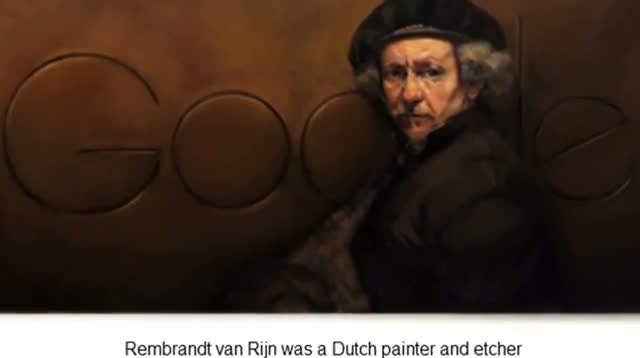
Rembrandt van Rijn - Google Doodle. On July 15th, 2013 Google honors Rembrandt van Rijn's with a 407th Birthday Google Doodle. Rembrandt Harmenszoon van Rijn ( 15 July 1606 -- 4 October 1669 ). Rembrandt van Rijn was a Dutch painter and etcher
The main topics of his paintings and etchings are portraits of his contemporaries self-portraits and illustrations of scenes from the Bible.
His most known works are 'Anatomy Lesson of Dr. Nicolaes Tulp', 'Night Watch', 'Belshazzar's Feast', 'Bathsheba at Her Bath' and 'Syndics of the Drapers' Guild'
Technology video | 1106 views

Dutch painter Rembrandt van Rijn's 407th birthday is being celebrated by Google through a doodle featuring his self portrait.
The self portrait or 'Self-Portrait with Beret and Turned-Up Collar' was made by Rembrandt in 1659. It is an oil on canvas painting and a celebrated work of the painter. The painting has been preserved in the National Gallery of Art in Washington DC (US) since 1937, where it's part of the Andrew W. Mellon Collection.
Rembrandt van Rijn is known as one of the greatest painters in Europe and Dutch Republic (Netherlands). The period when he contributed to art, is known as the Dutch Golden age which was known for its cultural achievements.
Art connoisseurs of the 20th century claimed that Rembrandt had made more than 600 paintings, about 400 etchings and 2,000 drawings, though modern day findings under Rembrandt Research Project mentions that he had done about 300 paintings. Among these, 40 paintings are said to be self-portraits. His work runs across the themes of portraits, landscape and narrative painting. His paintings featured rich detail, and depicted religious themes as well. Some of his greatest works include The Abduction of Europa, Judas Repentant, Returning the Pieces of Silver, The Artist in His Studio, Cottages before a Stormy Sky, The Three Trees, and The Night Watch, among several others.
Rembrandt van Rijn was born on 15 July 1606 in Leiden, in the Dutch Republ
Technology video | 594 views
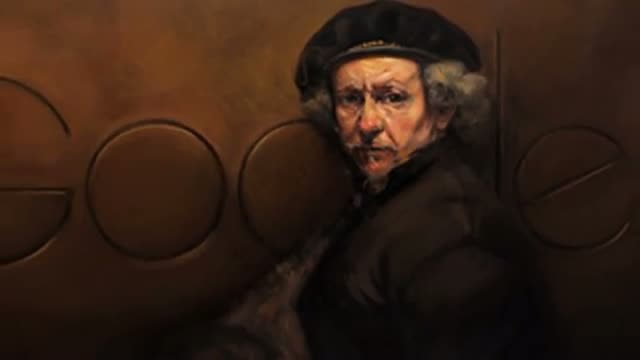
Google honors Rembrandt van Rijn with a nice doodle. Rembrandt was a dutch painter. He is generally considered one of the greatest painters and printmakers in European art history. Rembrandt paints a lot of self-portraits. The doodle-copy shows one of 1659 (53 years old). Happy birthday Rembrandt van Rijn.
Technology video | 456 views
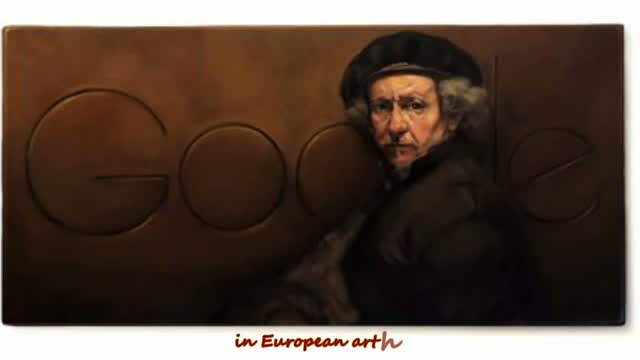
Google on Monday marked the 407th birth anniversary of Rembrandt van Rijn's with a doodle.
Rembrandt van Rijn was a Dutch painter who made major contributions to European art history.
He was born on July 15, 1606 in Dutch republic, which is now known as the Netherlands.
From a very young age he showed inclination towards painting and was apprenticed to some of the greatest painters of his time such as Pieter Lastman, Jacob van Swanenburgh and Jacob Pynas.
During the initial phase of his career he painted portraits, including several self-portraits.
In 1631, Rembrandt moved to Amsterdam, where he successfully established himself as a professional portraitist.
The subjects of Rembrandt's work include the themes of landscape, portraiture and narrative painting.
But his contemporaries glorified him as a masterly interpreter of biblical stories and admired his skills to represent emotions and attention to detail. He mastered the fine technique in portrayal of illusionistic form and also won recognition as a printmaker.
According to 20th century art enthusiasts and connoisseurs, Rembrandt van Rijn may have produced more than 600 paintings, 400 etchings and 2,000 drawings.
A few of his works are highly popular. Some of them include 'Anatomy Lesson of Dr Nicolaes Tulp' (1632), 'Portrait of the Shipbuilder Jan Rijcksen
Technology video | 526 views
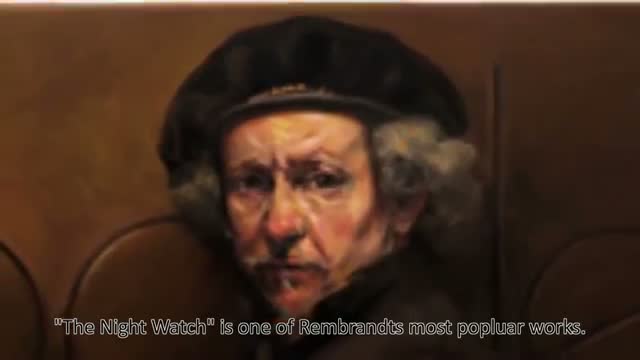
Rembrandt van Rijn - Google Doodle [HD] & Timeline of Rembrandt van Rijn's Life
Rembrandt van Rijn´s 407th birthday
There is a Google Doodle about Rembrandt van Rijn on July 15th, 2013. He is one of the most famous painters and etchers and from Dutch. Rembrandt had produced about 3000 works. Under it 2000 drawings 600 paintings and nearly 400 etchings.
Technology video | 580 views
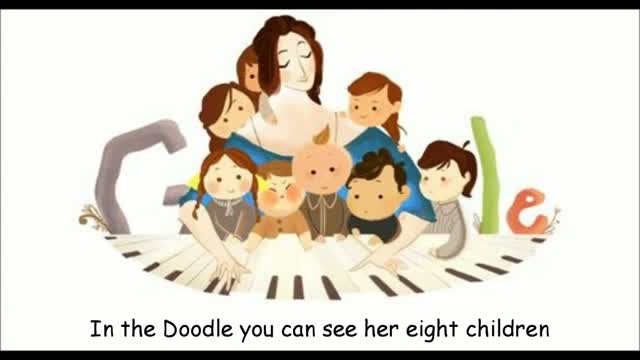
Clara Schumann's 193rd birth anniversary is the subject of the latest Google doodle. Clara Schumann was a German musician and composer. She was born on September 13, 1819 and was considered to be one of the most distinguished pianists of the Romantic era.
Today's doodle has Clara Schumann surrounded by her eight children, all of whom are seen playing the piano. There is an effective use of lively colours - blue, red, yellow and green to form the letters 'Google'.
Clara's parents separated when she was just four and was raised by her father Friedrich Wieck. She was inspired by her father and learnt the ropes of playing a piano. Her first performance was at the age of eight at the Leipzig home of Dr. Ernst Carus, director of a mental hospital at Colditz Castle. It is here that she met her future spouse and gifted pianist Robert Schumann. Schumann was nine years elder to Clara. He was so impressed with her performance that he left his studies to learn the piano from Clara's father.
Clara was considered to be a child prodigy and her music was famous all across Europe. When Clara was eighteen, she performed a series of recitals in Vienna between December 1837 and April 1838. This is how Clara felt about composing music, 'Composing gives me great pleasure...there is nothing that surpasses the joy of creation, if only because through it one wins hours of self-forgetfulness, when one lives in a world of sound.&qu
Technology video | 1101 views
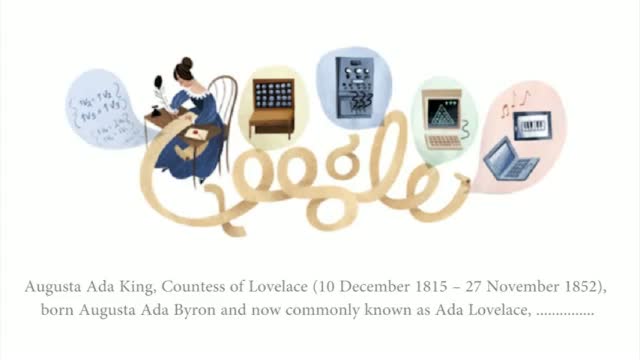
Ada Lovelace, born Augusta Ada Byron, was an English mathematician and writer widely known for her work on Charles Babbage's early mechanical general-purpose computer, the Analytical Engine. She worked on what is believed to be the first algorithm intended to be processed by a machine, making her the world's first known computer programmer.
Charles Babbage was an English mathematician, considered to be the father of the computer. He first proposed the use of a mechanical computer in 1822 for computing in the fields of astronomy and mathematics. He received funding from British government to build such a machine in 1823, and spent the next several years trying to build the Difference Engine.
By the time the government killed the project in 1842, they had given Babbage over ₤17,000, without receiving a working engine. By then, Babbage had moved on to building his more general purpose Analytical Engine, something he first described in 1837.
The Analytical Engine consisted of an arithmetic logic unit, control flow in the form of conditional branching and loops, and integrated memory, a design that continues to form the backbone of modern-day computers.
Ada Lovelace met and corresponded with Charles Babbage on many occasions, including socially and in relation to Babbage's Difference Engine and Analytical Engine. Ada became fascinated with his Difference Engine and translated Italian mathematician
Technology video | 799 views

Today is ghazal maestro Jagjit Singh's 72nd birthday and Google doodle is celebrating the fact in style.
Google has splashed Jagjit Singh's picture across its omnipresent search page.
Jagjit Singh, aka Jagmohan Singh was born in Rajasthan, but with father's encouragement shifted to Bombay to ply his trade and thereby for ever changed the way Indians look at music and the entertainment music that mostly, till then, was engrossed in kitsch love songs by Mohammad Rafi, Kishore Kumar, Lata Mangeshkar troika's Bollywood offering.
Jagjit Singh breathed fresh air into the genre with his melodious and soothing voice that took the middle and late seventies and much of the next two decades by storm.
He met and married Chitra Dutta there in 1969, (she divorced her first husband) and the duo created the album 'Unforgettables' that even today manages to move millions with its touching rendition - that was in 1976.
Jagjit Singh, along with Chitra went on to release many albums thereafter, that went on to become extremely popular and more than that his encouragement of the genre led to many pupils of his making it big in the industry, most notably Pankaj Udhaas.
Jagjit Singh also encouraged artistes from Pakistan to come to India to ply their trade and that led to Ghulam Ali becoming an instant hit with the Indian audiences.
Among the most popular of Jagjit Singh's albums were 'Live in Concert at Wemble
Technology video | 652 views
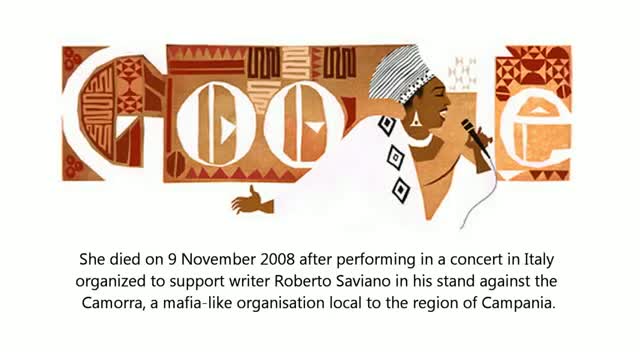
Miriam Makeba, born Zenzile Miriam Makeba, is the subject of Monday's Google doodle. Makeba was a singer and actress, probably best known for the song 'Pata Pata'.
Miriam Makeba was born in Johannesburg on 4 March 1932. Miriam spent the fix six months of her life in jail after her mother was sent to prison for six months for selling illegal beer when she was just eighteen days old. Her father died when Miriam was six years old.
Miriam started singing while she was very young, and was part of the choir of her primary school. Her professional career began in the 1950s when she was featured in the South African jazz group the Manhattan Brothers. She left the Manhattan Brothers to record with her all-woman group, The Skylarks, singing a mix of jazz and traditional melodies of South Africa.
In 1956, she released the single 'Pata Pata', which was played on all the radio stations and made her known all over. The song is considered by many to be Makeba's signature hit and the song has since been covered by many artists. Originally written and sung in the Xhosa language, the song's title means 'touch touch' in English.
In the late 50s, Miriam Makeba travelled to Europe and US, and gained some popularity. However, when she tried to return to South Africa in 1960 for her mother's funeral, she discovered that her South African passport had been cancelled. This forced her to kickstart her
Technology video | 817 views
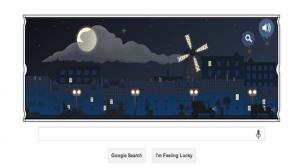
Claude Debussy, celebrated French music composer, is the subject of Thursday's Google doodle across the world. Debussy is remembered as one of the most prolific figures associated with impressionist music.
Google's animated doodle presents a moonlit riverside scene set to the tunes of Clair de lune (3rd movement from Suite bergamasque) or Moonlight, one of Debussy's best music pieces. The moonlight riverside scene features a star studded sky, flickering streets lights and chimney smoke rising to the tunes of the piece, in addition to a windmill, boats, cycles, cars and balloons.
The scene moves forward to depict rain falling on the river and concludes with two different boats crossing paths and the rowers sharing a red coloured umbrella.
Claude Debussy was born in Saint-Germain-en-Laye, in France on 22 August 1862. He started taking piano lessons in Cannes at the age of seven, where he had moved with his mother during the Franco-Prussian war. Debussy entered the Paris Conservatoire in 1872, where he spent 11 years.
In 1884 Debussy received the Prix de Rome honour for his composition L'enfant prodigue, and a scholarship to the Académie des Beaux-Arts, that featured a four-year residence at the Villa Medici, the French Academy in Rome, to pursue his studies, further. However, he found the the atmosphere at Villa Medici stifling, and left within a year, though he did compose four pieces that were sen
Technology video | 936 views

Join Our Bartending School The Spirit Vidyalaya, Call us on 7558204535
Check out our website - www.cocktailsindia.com
Check out my Podcast - 'Dada Bartender Podcast' https://open.spotify.com/show/0ub0ll4SUUWwHDo5qk5Nb5?si=7b3ac81e1c194caf
Please follow me on Instagram: https://www.instagram.com/cocktailsindia2016/
Instagram (2): www.instagram.com/dada.bartender
Please follow me on Facebook: https://www.facebook.com/profile.php?id=100092566239501&mibextid=LQQJ4d
For Business / Suggestion: dada@cocktailsindia.com
sponsor.cocktailsindia@gmail.com
Affiliate Link
********************************************************************
My Camera - Canon EOS 200D II - Link To Purchase - https://amzn.to/3ZXuNQD
My Best Camera - Sony A7 3 - https://amzn.to/3ZjAkAJ
My Sound - GODOX MoveLink M2 - https://amzn.to/3JcqaMJ
My Light setup - GODOX LC500R RGB LED Light Stick - https://amzn.to/3SQmu6P
My Lens Setup - Sigma 18-35mm f/1.8 DC for Canon - https://amzn.to/3ZDqbyD
My Lens Setup - Canon EF50MM F/1.8 STM Lens - https://amzn.to/41CEeX4
My Audio Setup - Zoom H1n Handy Recorder - https://amzn.to/3mudhFa
Home Bar Accessories - https://amzn.to/3LedEOv
Glassware - https://amzn.to/3KRPSrf
Ice mould - https://amzn.to/3EWlecr
Disclaimer:
The purpose of this channel is not to support or encourage underage drinking but to provide knowledge of the products we consume. This channel does not promote or sell any alcoholic product. The purpose of this channel is to strictly entertain and inform people about products available on the market. We are strictly against underage drinking and do not support it.
About The Channel:-
If you love homestyle cocktails, reviews of Alcohol, Drink knowledge, Bartending and many more then this channel is for you. India is the biggest alcohol consumer in the world. We buy and consume more whiskey in the worl
Cooking video | 13712 views

Kolkata’s Best Bartending School with LAB Felicity “The Spirit Vidyalaya”. If you love bartending then come and join us
Please call Sourav +91 755-8204535 for further dissertation. Thanks
What My Students Speaking? About My Bartending School “The Spirit Vidyalaya” Kolkata
Cooking video | 2387 views

PEG क्या है, इसे PEG क्यों कहा जाता है? | What Is Peg
Join Our Bartending School The Spirit Vidyalaya, Call us on 7558204535
Check out our website - www.cocktailsindia.com
Check out my Podcast - 'Dada Bartender Podcast' https://open.spotify.com/show/0ub0ll4SUUWwHDo5qk5Nb5?si=7b3ac81e1c194caf
Please follow me on Instagram: https://www.instagram.com/cocktailsindia2016/
Instagram (2): www.instagram.com/dada.bartender
Please follow me on Facebook: https://www.facebook.com/profile.php?id=100092566239501&mibextid=LQQJ4d
For Business / Suggestion: dada@cocktailsindia.com
sponsor.cocktailsindia@gmail.com
Affiliate Link
********************************************************************
My Camera - Canon EOS 200D II - Link To Purchase - https://amzn.to/3ZXuNQD
My Best Camera - Sony A7 3 - https://amzn.to/3ZjAkAJ
My Sound - GODOX MoveLink M2 - https://amzn.to/3JcqaMJ
My Light setup - GODOX LC500R RGB LED Light Stick - https://amzn.to/3SQmu6P
My Lens Setup - Sigma 18-35mm f/1.8 DC for Canon - https://amzn.to/3ZDqbyD
My Lens Setup - Canon EF50MM F/1.8 STM Lens - https://amzn.to/41CEeX4
My Audio Setup - Zoom H1n Handy Recorder - https://amzn.to/3mudhFa
Home Bar Accessories - https://amzn.to/3LedEOv
Glassware - https://amzn.to/3KRPSrf
Ice mould - https://amzn.to/3EWlecr
Disclaimer:
The purpose of this channel is not to support or encourage underage drinking but to provide knowledge of the products we consume. This channel does not promote or sell any alcoholic product. The purpose of this channel is to strictly entertain and inform people about products available on the market. We are strictly against underage drinking and do not support it.
About The Channel:-
If you love homestyle cocktails, reviews of Alcohol, Drink knowledge, Bartending and many more then this channel is for you. India is the biggest alcohol con
Cooking video | 2271 views

What is Wheat Beer? | व्हीट बीयर क्या है?
Join Our Bartending School The Spirit Vidyalaya, Call us on 7558204535
Check out our website - www.cocktailsindia.com
Check out my Podcast - 'Dada Bartender Podcast' https://open.spotify.com/show/0ub0ll4SUUWwHDo5qk5Nb5?si=7b3ac81e1c194caf
Please follow me on Instagram: https://www.instagram.com/cocktailsindia2016/
Instagram (2): www.instagram.com/dada.bartender
Please follow me on Facebook: https://www.facebook.com/profile.php?id=100092566239501&mibextid=LQQJ4d
For Business / Suggestion: dada@cocktailsindia.com
sponsor.cocktailsindia@gmail.com
Affiliate Link
********************************************************************
My Camera - Canon EOS 200D II - Link To Purchase - https://amzn.to/3ZXuNQD
My Best Camera - Sony A7 3 - https://amzn.to/3ZjAkAJ
My Sound - GODOX MoveLink M2 - https://amzn.to/3JcqaMJ
My Light setup - GODOX LC500R RGB LED Light Stick - https://amzn.to/3SQmu6P
My Lens Setup - Sigma 18-35mm f/1.8 DC for Canon - https://amzn.to/3ZDqbyD
My Lens Setup - Canon EF50MM F/1.8 STM Lens - https://amzn.to/41CEeX4
My Audio Setup - Zoom H1n Handy Recorder - https://amzn.to/3mudhFa
Home Bar Accessories - https://amzn.to/3LedEOv
Glassware - https://amzn.to/3KRPSrf
Ice mould - https://amzn.to/3EWlecr
Disclaimer:
The purpose of this channel is not to support or encourage underage drinking but to provide knowledge of the products we consume. This channel does not promote or sell any alcoholic product. The purpose of this channel is to strictly entertain and inform people about products available on the market. We are strictly against underage drinking and do not support it.
About The Channel:-
If you love homestyle cocktails, reviews of Alcohol, Drink knowledge, Bartending and many more then this channel is for you. India is the biggest alcohol consumer in th
Cooking video | 2071 views
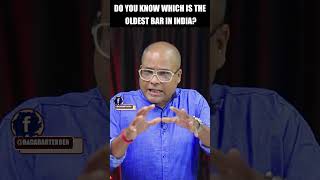
भारत में पहला BAR कौन सा है? Which is the First BAR in India? Do you know?
#firstbar #Indiasfirstbar #bar #cocktailsindia
Check out my Podcast - 'Dada Bartender Podcast' https://open.spotify.com/show/0ub0ll4SUUWwHDo5qk5Nb5?si=7b3ac81e1c194caf
Please follow me on Instagram: https://www.instagram.com/cocktailsindia2016/
Please follow me on Facebook: https://www.facebook.com/cocktailsindia1975/
For Business / Suggestion: sponsor.cocktailsindia@gmail.com
Affiliate Link
********************************************************************
My Camera - Canon EOS 200D II - Link To Purchase - https://amzn.to/3ZXuNQD
My Best Camera - Sony A7 3 - https://amzn.to/3ZjAkAJ
My Sound - GODOX MoveLink M2 - https://amzn.to/3JcqaMJ
My Light setup - GODOX LC500R RGB LED Light Stick - https://amzn.to/3SQmu6P
My Lens Setup - Sigma 18-35mm f/1.8 DC for Canon - https://amzn.to/3ZDqbyD
My Lens Setup - Canon EF50MM F/1.8 STM Lens - https://amzn.to/41CEeX4
My Audio Setup - Zoom H1n Handy Recorder - https://amzn.to/3mudhFa
Home Bar Accessories - https://amzn.to/3LedEOv
Glassware - https://amzn.to/3KRPSrf
Ice mould - https://amzn.to/3EWlecr
Disclaimer:
The purpose of this channel is not to support or encourage underage drinking but to provide knowledge of the products we consume. This channel does not promote or sell any alcoholic product. The purpose of this channel is to strictly entertain and inform people about products available on the market. We are strictly against underage drinking and do not support it.
About The Channel:-
If you love homestyle cocktails, reviews of Alcohol, Drink knowledge, Bartending and many more then this channel is for you. India is the biggest alcohol consumer in the world. We buy and consume more whiskey in the world than anyone else. This channel helps give information about your favorite drink. How to make fantastic cocktails at ho
Cooking video | 1957 views

एक Wine की बोतल की सेल्फ लाइफ क्या होती है? What is the shelf-life of a bottle of wine?
#wine #Wineshelflife #cocktailsindia #dadabartender
Join Our Bartending School The Spirit Vidyalaya, Call us on 7558204535
Check out our website - www.cocktailsindia.com
Check out my Podcast - 'Dada Bartender Podcast' https://open.spotify.com/show/0ub0ll4SUUWwHDo5qk5Nb5?si=7b3ac81e1c194caf
Please follow me on Instagram: https://www.instagram.com/cocktailsindia2016/
Instagram (2): www.instagram.com/dada.bartender
Please follow me on Facebook: https://www.facebook.com/profile.php?id=100092566239501&mibextid=LQQJ4d
For Business / Suggestion: dada@cocktailsindia.com
sponsor.cocktailsindia@gmail.com
Affiliate Link
********************************************************************
My Camera - Canon EOS 200D II - Link To Purchase - https://amzn.to/3ZXuNQD
My Best Camera - Sony A7 3 - https://amzn.to/3ZjAkAJ
My Sound - GODOX MoveLink M2 - https://amzn.to/3JcqaMJ
My Light setup - GODOX LC500R RGB LED Light Stick - https://amzn.to/3SQmu6P
My Lens Setup - Sigma 18-35mm f/1.8 DC for Canon - https://amzn.to/3ZDqbyD
My Lens Setup - Canon EF50MM F/1.8 STM Lens - https://amzn.to/41CEeX4
My Audio Setup - Zoom H1n Handy Recorder - https://amzn.to/3mudhFa
Home Bar Accessories - https://amzn.to/3LedEOv
Glassware - https://amzn.to/3KRPSrf
Ice mould - https://amzn.to/3EWlecr
Disclaimer:
The purpose of this channel is not to support or encourage underage drinking but to provide knowledge of the products we consume. This channel does not promote or sell any alcoholic product. The purpose of this channel is to strictly entertain and inform people about products available on the market. We are strictly against underage drinking and do not support it.
About The Channel:-
If you love homestyle cocktails, reviews of Alcohol, Drink kn
Cooking video | 2037 views